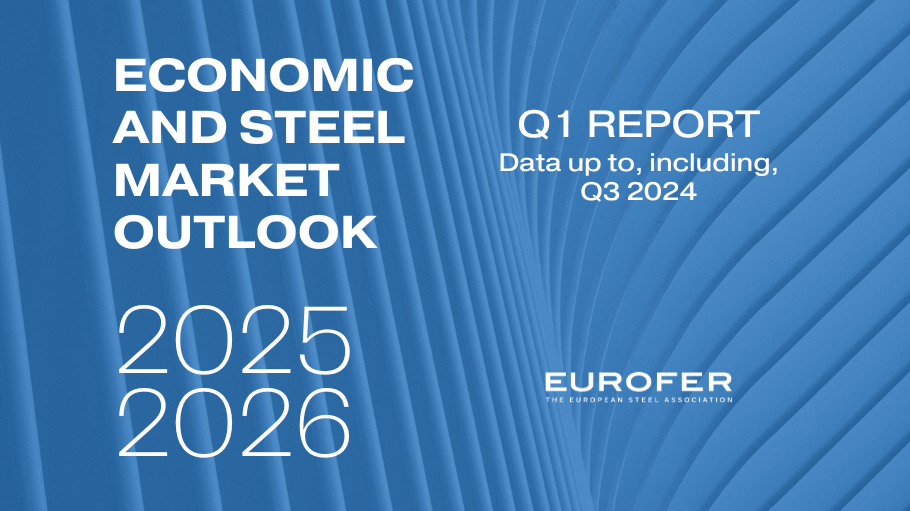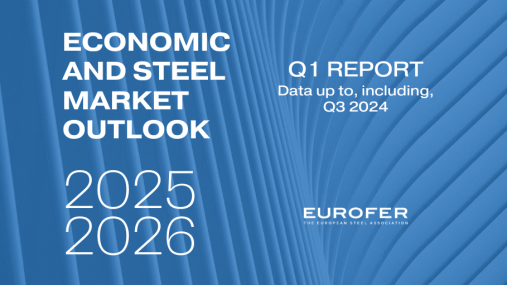
Press releases » Downside factors persist, no relief in sight for the steel market outlook in the short to medium term
Downside factors persist, no relief in sight for the steel market outlook in the short to medium term
Downloads and links
Recent updates

Brussels, 06 February 2025 – The economic and geopolitical conditions that have affected the European steel market over the past two years show no signs of improvement and have further deepened their negative impact on the sector in 2024. Growing uncertainty continues to weigh also on 2025 and 2026, with the outlook hinging on unpredictable developments especially as regards international trade. According to EUROFER’s latest Economic and Steel Market Outlook, the recession in apparent steel consumption in 2024 will be steeper than previously projected (-2.3%, down from -1.8%) and the expected recovery in 2025 has now been downgraded (+2.2%, down from +3.8%). Similarly, steel-using sectors’ recession has been revised downwards for 2024 (-3.3% from -2.7%), while growth projections for 2025 have also been lowered (+0,9% from +1.6%). Some acceleration is not expected until 2026 (+2.1%). Steel imports remain at historically high levels (28%) also in the third quarter of 2024.
“We can no longer cope with a situation where external factors beyond steelmakers’ control – massive steel dumping, uncompetitive energy and carbon prices, collapsing demand, trade and geopolitical tensions - are structurally undermining our industry. The initiatives the European Commission will put forward in the coming weeks will determine the future of the EU steel industry, its quality jobs and, with it, the future of EU manufacturing, competitiveness and security. The thousands of European steel and industry workers who took to the streets of Brussels are a powerful reminder of what is at stake”, said Axel Eggert, Director General of the European Steel Association (EUROFER), following the publication of the Economic and Steel Market Outlook Q1 2025.
In the third quarter of 2024, apparent steel consumption continued its downward trend (-0.9%, following -1.4%), reaching a total volume of 30.4 million tonnes. No improvement is expected before the first quarter of 2025, with consumption volumes remaining well below pre-pandemic levels. The overall evolution of steel demand remains subject to very high uncertainty.
Also domestic deliveries further declined (-2.3%, after -1.6%) in the third quarter. During the same period, imports resumed their upward trend (+1%) while maintaining their overall share at a historical high of 28%.
The performance of steel-using sectors deteriorated further, recording another sharp drop (-4.1%, after -2.1%) in the third quarter of 2024. This decline was driven by recession especially in the automotive and construction, exacerbating difficulties already faced by the other sectors. As a result, projections for the Steel Weighted Industrial Production index (SWIP) have been cut once again for both 2024 and 2025, with recession deepening to -3.3% from -2.7% and recovery weakening to +0.9% from +1.6%, respectively. Moderate growth is expected in 2026 (+2.1%).
Contact
Lucia Sali, Spokesperson and Head of Communications, +32 2 738 79 35, (l.sali@eurofer.eu)
About the European Steel Association (EUROFER)
EUROFER AISBL is located in Brussels and was founded in 1976. It represents the entirety of steel production in the European Union. EUROFER members are steel companies and national steel federations throughout the EU. The major steel companies and national steel federation of Turkey, Ukraine and the United Kingdom are associate members.
The European Steel Association is recorded in the EU transparency register: 93038071152-83.
About the European steel industry
The European steel industry is a world leader in innovation and environmental sustainability. It has a turnover of around €191 billion and directly employs around 303,000 highly-skilled people, producing on average 140 million tonnes of steel per year. More than 500 steel production sites across 22 EU Member States provide direct and indirect employment to millions more European citizens. Closely integrated with Europe’s manufacturing and construction industries, steel is the backbone for development, growth and employment in Europe.
Steel is the most versatile industrial material in the world. The thousands of different grades and types of steel developed by the industry make the modern world possible. Steel is 100% recyclable and therefore is a fundamental part of the circular economy. As a basic engineering material, steel is also an essential factor in the development and deployment of innovative, CO2-mitigating technologies, improving resource efficiency and fostering sustainable development in Europe.

Download files or visit links related to this content
Strasbourg, 17 December 2025 – The European Commission’s latest proposals on the Carbon Border Adjustment Mechanism (CBAM), unveiled today, correctly identify several loopholes that risk undermining its effectiveness, notably regarding EU exports, downstream sectors and circumvention practices. However, despite these laudable efforts, the measures put forward fail to deliver a comprehensive and durable response to carbon and jobs leakage, warns the European Steel Association (EUROFER).
A milestone occasion to quickly and effectively restore affordable electricity, to relaunch the
decarbonization and strengthen the international competitiveness of the European steel
industry.
Brussels, 02 December 2025 – Unchanged negative conditions – U.S. tariffs and trade disruptions, economic and geopolitical tensions, protracted weak demand and still high energy prices – continue to weigh on the European steel market. EUROFER’s latest Economic and Steel Market Outlook confirms for 2025 another recession in both apparent steel consumption (-0.2%, unchanged) and steel-using sectors (-0.5%, revised from -0.7%). A potential recovery is expected only in 2026 for the Steel Weighted Industrial Production index (SWIP) (+1.8%, stable) and for apparent steel consumption (+3%, slightly revised from +3.1%) – although consumption volumes would still remain well below pre-pandemic levels. Steel imports retained historically high shares (27%), while exports plummeted (-9%) in the first eight months of 2025.